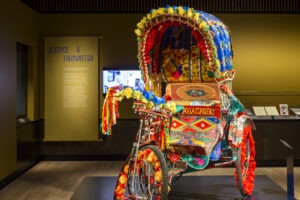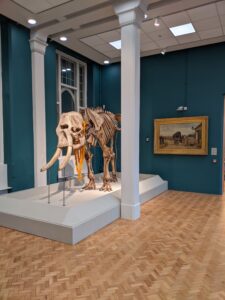“Thank you for taking a photo of that object. I chose that one,” says a voice over my shoulder in the new South Asia gallery at Manchester Museum.
A ‘co-curator’ of the exhibition – one of 30 members of the public who have selected, researched and written about the objects on display – stands by me, bristling with pride at their work on display in the new gallery. The exhibit sits at the centre of the newly revamped Manchester Museum which has reopened 18 months after it closed its doors for redevelopment.
We chat for a few moments and she tells me why she chose this object and the complexities of working collaboratively with a museum and other contributors during various lockdowns. She says how proud she feels to see it in the museum, on permanent display, her words on display, very present, and the being seen.
Co-curation isn’t new to museums. It’s been a growing trend in recent decades, whereby the institutions give up some of their authority, inviting others from outside – often people with lived experience of the subject at hand – to tell their story. Sometimes it feels like a box-ticking exercise, where people pick an object and write caption along the lines of “I like this because …”
Manchester Museum’s displays are way ahead in this respect. The labels contain insightful and meaningful content that’s been researched, written – yes curated – by people who are not within the employ of the institution. The content is thorough, insightful, thought-provoking, challenging at time and leaves me with a real respect for the writers, the co-curators.

The Singh Twins mural. Photo courtesy of Manchester Museum.
The team of co-curators have been brave, encouraging the museum to deal with subjects others might shy away from, including queer identity, the plight of the Rohingya, and the complications of collecting and displaying museum objects in a context of empire and imperialism. The conversations which took place behind the scenes are borne out in the interpretation that now graces the object labels in this gallery.
This process has been part of Hello Future, the £15 million development project that has seen the refurbishment of the museum’s home on Oxford Road with new facilities, a decent-sized temporary exhibition space and yes, a new gift shop, stacked with books, cute tea towels and pocket money trinkets. It’s a project with people and their stories at its heart.
Back to the gallery. Do I have the heart to tell the co-curator that I wasn’t actually taking a photo of their label, but was in fact using my phone’s torch to light up their text? The copy, printed white on a black background, is very small and is not well lit. I feel slightly awkward, peering down at the label, trying to make out what it says.
Exhibition designers have a lot to weigh up when putting a display together and lighting levels are part of that, especially when light-sensitive materials are featured. But if the light needs to be low, my suggestion is not to print the text so small and to hide it away. This kind of exhibition design actively puts barriers between audiences and the great content that’s written on the labels. For me, this display undoes some of the sterling curatorial work that’s taken place behind the scenes, building rapport and trust with the South Asian community and changing the way museum content is created. To see their words as the very smallest in the gallery, not the largest, is to reduce their importance for visitors, many of which will have no idea what co-curation even is.

South Asia Gallery. Photo by Gareth Gardner.
Visitors to the nearby China gallery, also a new addition in the museum’s renovation, face similar challenges. Despite some ingenious display techniques, the choice of font size is still way too small and the text way too poorly lit. Watching visitors stoop and peer, hunting for labels and squinting into the cases, I gave up.
This is a real disappointment. We’ve been waiting to see these new galleries for a few years, following the story of co-creation, of story-building, of exciting changes. And despite some inspirational changes to the way museum content is created, behind the scenes using modern socially engaged curation techniques that enrich and enliven the displays, it seems that the habits of exhibit designers are stuck a few decades ago.

Manchester Museum. Credit: Steve Slack
Northern Soul asked Manchester Museum for comment on this point. A spokesperson told us: “Large print text is available for the Lee Kai Hung Chinese Culture Gallery. In terms of the South Asia Gallery, there is a lot of text to fit in the gallery as the Collective had so much to say. We are aware that there is a need for large print versions of the interpretations – we are working on this and it will be available very soon. Our aim is to be more inclusive and caring and we will be working with an inclusion consultant in the near future to help us drive forward this critical work.”
Manchester Museum is right at the forefront of socially engaged museum practice and these galleries really ought to be celebrated. It’s just a shame that, in the delivery, the visitor experience wasn’t as considered as the curatorial process.
Main image courtesy of Manchester Museum
Manchester Museum is open Tuesday to Sunday. For more information on opening hours and exhibitions, click here.






